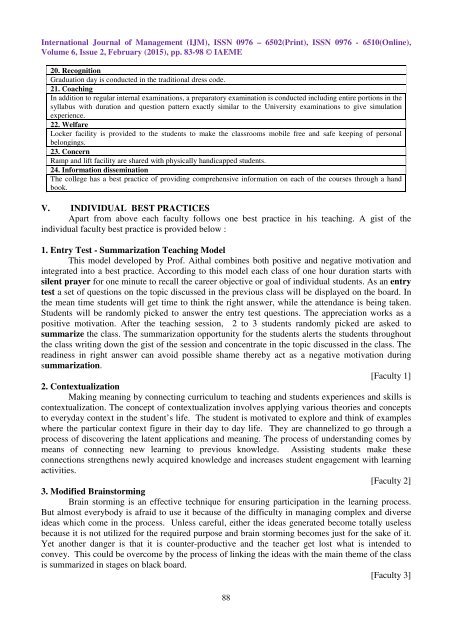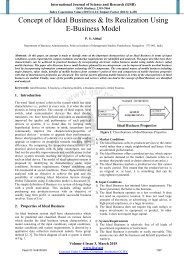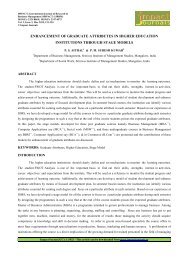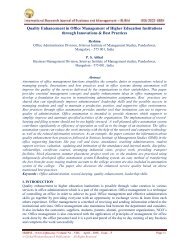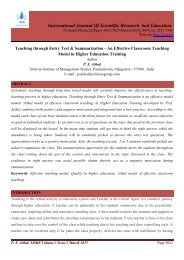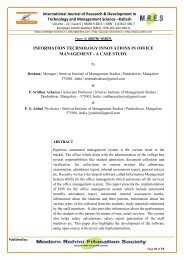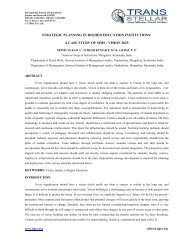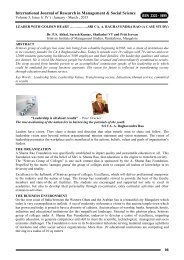How Innovations and Best Practices can Transform Higher Education Institutions : A case study of SIMS
Education has become competitive so as the educational institutions. In order to survive the competition, institutions have to improve the quality of their services. Changes in culture, aspiration and levels of skills required in securing employment for students, force higher education institutions today to rework on their educational models and add value to each and every aspect of their service. Innovations and best practices serve to enhance quality and add value. Srinivas Institute of Management Studies (SIMS), which combines technology, management and social service education has identified and implemented innovations and best practices to differentiate itself among the competitors and to add value in its educational services. In this paper, we have discussed innovations, small and big, develped indigineously and implemented during last four years. They are broadly classified under six key aspects namely "curricular aspects, teaching-learning and evaluation, research, consultancy and extension, infrastructure and learning resources, student support and progression, and governance, leadership, and management". The paper also contains some of the intitutional and individual faculty best practices having visible impact on the quality of higher education imparted by the institution. The best practices concern admission, fees, attendance, teaching, performance, skill building, employability, student involvement, collective learning, value addition, ensuring transparency, information dessimination etc. Finally two institutional best practices are elaborated with its aim of practice, underlying principles and concepts, particular contextual features or challenging issues that have had to be addressed in designing and implementing the practice, and its implementation, including its uniqueness in Indian higher education, evidence of success, identifying the problems encountered and resources required to implement the practice.
Education has become competitive so as the educational institutions. In order to survive the competition, institutions have to improve the quality of their services. Changes in culture, aspiration
and levels of skills required in securing employment for students, force higher education institutions
today to rework on their educational models and add value to each and every aspect of their service. Innovations and best practices serve to enhance quality and add value. Srinivas Institute of
Management Studies (SIMS), which combines technology, management and social service education
has identified and implemented innovations and best practices to differentiate itself among the competitors and to add value in its educational services. In this paper, we have discussed
innovations, small and big, develped indigineously and implemented during last four years. They are
broadly classified under six key aspects namely "curricular aspects, teaching-learning and evaluation, research, consultancy and extension, infrastructure and learning resources, student support and progression, and governance, leadership, and management". The paper also contains some of the
intitutional and individual faculty best practices having visible impact on the quality of higher education imparted by the institution. The best practices concern admission, fees, attendance, teaching, performance, skill building, employability, student involvement, collective learning, value
addition, ensuring transparency, information dessimination etc. Finally two institutional best practices are elaborated with its aim of practice, underlying principles and concepts, particular contextual features or challenging issues that have had to be addressed in designing and implementing the practice, and its implementation, including its uniqueness in Indian higher
education, evidence of success, identifying the problems encountered and resources required to implement the practice.
You also want an ePaper? Increase the reach of your titles
YUMPU automatically turns print PDFs into web optimized ePapers that Google loves.
International Journal <strong>of</strong> Management (IJM), ISSN 0976 – 6502(Print), ISSN 0976 - 6510(Online),<br />
Volume 6, Issue 2, February (2015), pp. 83-98 © IAEME<br />
20. Recognition<br />
Graduation day is conducted in the traditional dress code.<br />
21. Coaching<br />
In addition to regular internal examinations, a preparatory examination is conducted including entire portions in the<br />
syllabus with duration <strong>and</strong> question pattern exactly similar to the University examinations to give simulation<br />
experience.<br />
22. Welfare<br />
Locker facility is provided to the students to make the classrooms mobile free <strong>and</strong> safe keeping <strong>of</strong> personal<br />
belongings.<br />
23. Concern<br />
Ramp <strong>and</strong> lift facility are shared with physically h<strong>and</strong>icapped students.<br />
24. Information dissemination<br />
The college has a best practice <strong>of</strong> providing comprehensive information on each <strong>of</strong> the courses through a h<strong>and</strong><br />
book.<br />
V. INDIVIDUAL BEST PRACTICES<br />
Apart from above each faculty follows one best practice in his teaching. A gist <strong>of</strong> the<br />
individual faculty best practice is provided below :<br />
1. Entry Test - Summarization Teaching Model<br />
This model developed by Pr<strong>of</strong>. Aithal combines both positive <strong>and</strong> negative motivation <strong>and</strong><br />
integrated into a best practice. According to this model each class <strong>of</strong> one hour duration starts with<br />
silent prayer for one minute to recall the career objective or goal <strong>of</strong> individual students. As an entry<br />
test a set <strong>of</strong> questions on the topic discussed in the previous class will be displayed on the board. In<br />
the mean time students will get time to think the right answer, while the attendance is being taken.<br />
Students will be r<strong>and</strong>omly picked to answer the entry test questions. The appreciation works as a<br />
positive motivation. After the teaching session, 2 to 3 students r<strong>and</strong>omly picked are asked to<br />
summarize the class. The summarization opportunity for the students alerts the students throughout<br />
the class writing down the gist <strong>of</strong> the session <strong>and</strong> concentrate in the topic discussed in the class. The<br />
readiness in right answer <strong>can</strong> avoid possible shame thereby act as a negative motivation during<br />
summarization.<br />
[Faculty 1]<br />
2. Contextualization<br />
Making meaning by connecting curriculum to teaching <strong>and</strong> students experiences <strong>and</strong> skills is<br />
contextualization. The concept <strong>of</strong> contextualization involves applying various theories <strong>and</strong> concepts<br />
to everyday context in the student’s life. The student is motivated to explore <strong>and</strong> think <strong>of</strong> examples<br />
where the particular context figure in their day to day life. They are channelized to go through a<br />
process <strong>of</strong> discovering the latent applications <strong>and</strong> meaning. The process <strong>of</strong> underst<strong>and</strong>ing comes by<br />
means <strong>of</strong> connecting new learning to previous knowledge. Assisting students make these<br />
connections strengthens newly acquired knowledge <strong>and</strong> increases student engagement with learning<br />
activities.<br />
[Faculty 2]<br />
3. Modified Brainstorming<br />
Brain storming is an effective technique for ensuring participation in the learning process.<br />
But almost everybody is afraid to use it because <strong>of</strong> the difficulty in managing complex <strong>and</strong> diverse<br />
ideas which come in the process. Unless careful, either the ideas generated become totally useless<br />
because it is not utilized for the required purpose <strong>and</strong> brain storming becomes just for the sake <strong>of</strong> it.<br />
Yet another danger is that it is counter-productive <strong>and</strong> the teacher get lost what is intended to<br />
convey. This could be overcome by the process <strong>of</strong> linking the ideas with the main theme <strong>of</strong> the class<br />
is summarized in stages on black board.<br />
[Faculty 3]<br />
88


